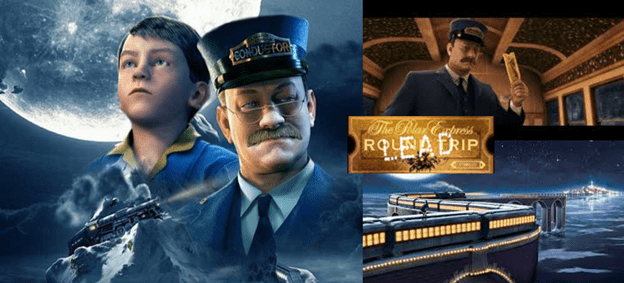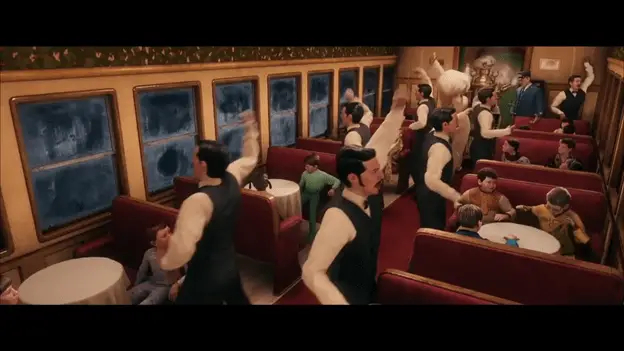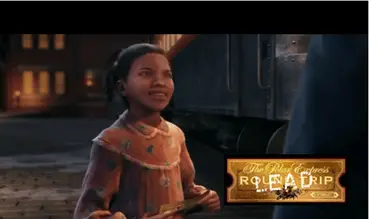In 2004, The Polar Express movie, based on the 1984 now classic book, was released in a unique 3D animated format based on live action capture. It’s become an annual feature in movie theaters during the holidays – and delightfully some interesting lessons on leadership.
The story is simple. Young children, exemplified by the “Hero Boy,” are drawn to the magical “Polar Express” stopping outside their homes, for a journey to the North Pole. It’s Christmas Eve, and before getting on the train, the story shows how the “Hero Boy” is doubting his belief in Santa Claus.
- Leaders are flexible; they can be firm and sensitive.
In one of the six roles played by Tom Hanks, the Conductor is one of the main characters. He portrays a strong-handed leader, enforcing with direct statements the rules and timetables of the train. He non-verbally communicates his frustration with the indecisiveness of the “Hero Boy” and “Billy” at the same time patiently awaiting their decisions to board the train. When a rule is broken by the “Hero Boy” who clearly intends to help “Billy,” the Conductor is loudly and firmly direct in his criticism, “Who in the blazes pulled that cord?” only seconds later to be quietly supporting and helping the situation. While keeping focused on the goal of reaching the North Pole, with a tight schedule to maintain, he is equally aware of the individual personalities and needs of his passengers.
In many ways the Conductor reminds me of two of my first managers, covering more than ten years of my school year jobs. Each was firm in his directives, yet sensitive to personalities and individual needs. They were flexible in their leadership style – a trait that today is considered very important for effective leaders.
- Leaders communicate and support vision – with enthusiasm.
When the Conductor tells his young passengers where they’re going, in a variety of interactions, he doesn’t just calmly say “The North Pole.” He states it with excitement, his words communicating a picture of the magical place portrayed in the story. He exudes the same enthusiasm describing the train, the excitement of the journey on “The Polar Express.”
I’ve listened to dozens of CEO’s, senior executives, and key managers present their organization’s vision, mission, and goals to audiences of employees – frequently with no enthusiasm and the excitement of reading a dictionary. It’s even been true for leaders of religious organizations who present visions not even close to the spiritual promises of their faith. Visions should be vivid. They should generate enthusiasm on the part of everyone in an organization so that they understand, support, and take actions to help achieve the vision. The Conductor presents the vision and the journey with excitement and enthusiasm.
To the North Pole of course. This is the Polar Express
- Leadership Recognize the Need for Customer Service that Exceeds Expectations
Minutes into the journey, the Conductor calls for refreshments and a team of singing, dancing waiters appear to magically serve hot chocolate.
Hot! Hot!
Yo, we got it!
Hot chocolate!Here, we’ve only got one rule:
Never ever let it cool!
The Conductor is actively involved in the performance, making sure that the service exceeds expectations and “wow’s” the passengers. The success of the “wow” factor is visible on the faces of the children. But the active involvement of the Conductor in delivering the service is an even more important message for leaders.
- Leadership Is Always a Journey of Self-Discovery
The major theme of “The Polar Express” is self-discovery. The “Hero Boy” is trying to discover whether or not he still believes in Santa Claus. Billy is struggling with an even deeper belief in Christmas. “Christmas just doesn’t work out for me.” The “Hobo” expresses an alternative view of life as he describes his journey of discovery. The “Know-it-all Boy” eventually takes a major step in his self-discovery. Even the Conductor adds elements to the self-discovery as he challenges and supports the children – and as he gives a peek into Santa Claus’s new idea for “re-bicycling” broken toys.
For leaders and managers who want to maintain and increase their effectiveness, it is always a continuing journey of self-discovery, a desire to learn. This is an important factor in “emotional intelligence,” one of the strongest factors proven to relate to effective leadership.
- Leaders Are Coaches; Not All Coaches Are Leaders
As noted above, the Conductor is clearly both a strong leader and a supportive coach. And in his unique way, the “Hobo” coaches the “Hero Boy” at several points in the story. He even provides direct physical support to the boy as he saves him during the potentially catastrophic attempts to fix the headlight on the engine. The “Hero Boy” is open to listening and following advice from different sources.
- Leadership Emerges in Challenging Situations
In “The Polar Express,” it’s the leadership of a young girl, the “Hero Girl,” portrayed by then future pop star Tinashe. As a team, the “Hero Boy,” “Hero Girl,” and Billy, emerge to get to the celebration at the North Pole after their train car is separated from the train. The “Hero Girl” becomes the leader of the team. There were clues to her leadership potential very early in the story as she takes the initiative in encouraging the “Hero Boy” to help Billy. She hides a cup of hot chocolate under her seat – before all the cups are whisked away by the dancing waiters – so that she can take it to Billy, who’s shyly hiding alone in the last car of the train.
But now, as the three youngsters face the magical challenges of activities at the North Pole, challenges that provide insights into how Santa Claus’s massive, magical toy business operates, the “Hero Girl” is aware, assesses situations and demonstrates multiple situations where she’s encouraging, even pushing, and supporting Billy and the “Hero Boy” to keep moving forward. Asked if she’s sure about the direction they’re heading, her response is simple: “Absolutely!”
Santa Claus, of course, “knows” about her leadership, later telling her: “And you, young lady, a lady of decision, full of confidence and spirit…keep up the good work!”
Leaders emerge. It’s the responsibility of any organization to be alert to leadership behavior, to nurture leadership behavior.
Conclusion
As the children board the train to return to their homes, the Conductor again punches their tickets. No surprise that the Hero Boy’s ticket is punched “BELIEVE,” the clues to that came early in the story. The surprise comes when the HERO Girl’s ticket is punched “LEAD,” which explains: “Leader, Leadership, Lead the way.” The girl has clearly demonstrated some key leadership skills, and it’s been recognized by the Conductor, her friends, and Santa Claus.
While saying goodbye to the “Hero Boy” as he disembarks the train, the Conductor provides the best summary of the leadership, vision, and learning messages of “The Polar Express”:
“One thing about trains. It doesn’t matter where they’re going.
What matters is deciding to get on.”
If you’d like to experience the magic of The Polar Express, you can find the Blu-Ray, DVD, or streaming video of The Polar Express at Amazon.







Please note: I reserve the right to delete comments that are offensive or off-topic.